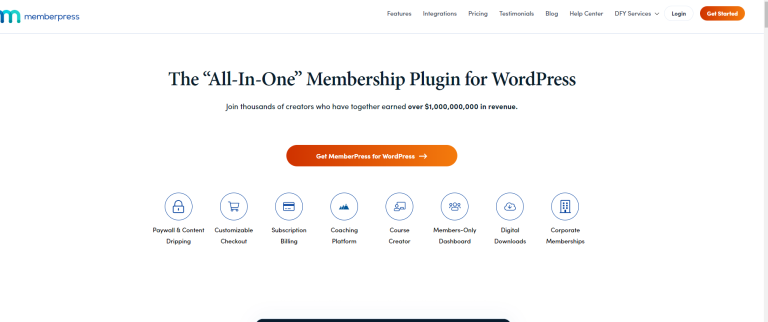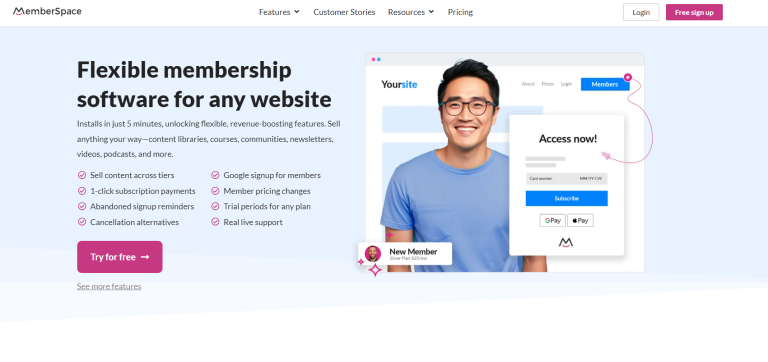Free Trials vs Low Entry Fee for Memberships

Spotify gives you 30 days free, Netflix charges $1 for your first month, and Costco makes you pay $60 upfront just to walk through their doors.
These companies have taken completely different approaches to the same fundamental challenge that every membership business faces: how do you convert curious browsers into committed paying members?
In this post, I will discuss approach drives better long-term member retention and revenue based on psychology, real-world data, and practical applications across industries so that you can make the best decision for your situation.
Understanding What We’re Really Comparing
A free trial gives users full or partial access to your product or service for a limited time without requiring any payment upfront.
Most commonly, you’ll see 7-day, 14-day, or 30-day periods, and these trials can either limit features or limit time. The approach dominates industries like software-as-a-service, streaming entertainment, fitness apps, and subscription boxes.
Low entry fee models take a different approach by charging a minimal upfront cost, typically between $1 and $20, to access core membership benefits. This strategy reduces commitment friction without eliminating the financial investment entirely. Think of gym day passes, introductory consulting sessions, or first-month discounts on premium services.
The landscape has shifted dramatically over the past decade as digital transformation changed customer expectations around trying before buying.
Traditional industries that once operated on “no trial, full commitment” models have been forced to adapt to customer-centric approaches. Mobile apps and one-click purchasing have made trial signup so frictionless that the challenge has shifted from getting people to try your service to getting them to actually engage with it meaningfully.
Market saturation has also changed the game. When customers have dozens of similar options, each offering their own trial or introductory pricing, the trial itself becomes less of a competitive advantage and more of a table stakes requirement.
The Psychology Behind Why People Commit
The most fascinating aspect of membership pricing isn’t the economics but the psychology. When someone pays even a small amount for access to something, they immediately develop psychological ownership of that experience.
The sunk cost effect kicks in the moment money changes hands, no matter how small the amount. Once people have invested financially in something, they’re more likely to engage with it actively because abandoning it means accepting a loss. This explains why a $1 trial often leads to higher engagement rates than a completely free trial, even though the financial difference is negligible.
There’s also a quality perception issue with free offerings. In consumer psychology, price often serves as a signal for value. When something is completely free, especially in a market where competitors charge for similar services, consumers may unconsciously assume it’s of lower quality or that there’s a hidden catch. Which is why a small entry fee can actually increase perceived value and trust.
Careful Using Free
The power of “free” in marketing is undeniable, but it comes with unexpected downsides.
Free trials tend to attract what marketers call “trial collectors” – people who sign up for free offerings with no genuine intention of converting to paid memberships. These users inflate your signup numbers but drain resources and skew your conversion metrics.
Decision fatigue plays a role too. When faced with multiple free options, consumers often struggle to choose and may end up choosing nothing. A low entry fee can actually simplify the decision-making process by filtering options and making the choice feel more deliberate and researched.
What the Numbers Tell Us About Conversion and Retention
The performance metrics between free trials and low entry fees reveal patterns that often surprise business owners.
Pros and Cons of Free Trials
Free trials typically generate much higher initial signup rates, which can be exciting for marketing teams and business owners who love seeing those registration numbers climb. However, the conversion rates from trial to paid membership often tell a different story.
Most free trial conversion rates hover in ranges that might seem disappointing at first glance. Software companies often see anywhere from 15% to 25% of free trial users convert to paid plans, while fitness and entertainment services sometimes see even lower rates. The challenge isn’t just converting trial users but identifying which trial users are actually serious prospects versus those who are just browsing.
Pros and Cons of Low Entry Free
Low entry fee models typically see much lower initial signup volumes but significantly higher conversion rates to full membership. The self-selection effect works powerfully here. People willing to pay even a small amount upfront have already demonstrated financial capacity and genuine interest. They’ve crossed the psychological barrier from curiosity to commitment before they even experience your full offering.
The retention story becomes even more interesting when you track members six months or a year after initial signup. Members acquired through low entry fees often show higher engagement rates, lower churn, and higher lifetime values. They attend more sessions, use more features, and stay subscribed longer than their free trial counterparts.
Revenue Impact and Financial Considerations

The financial implications of trial strategy extend far beyond initial signup numbers. Free trials create a delayed revenue model where you’re essentially betting that your product experience will be compelling enough to convert browsers into buyers within a limited timeframe. This approach requires significant confidence in your onboarding process and product value demonstration.
Cash flow considerations matter more than many businesses initially realize. Supporting free trial users costs money in server resources, customer support, content delivery, and marketing follow-up, but generates zero immediate revenue. For businesses with tight cash flow or limited runway, this can create sustainability challenges.
Low entry fee models provide immediate revenue validation and help offset customer acquisition costs from day one. Even a $5 entry fee can significantly improve your customer acquisition cost ratios and provide earlier cash flow to reinvest in growth. The psychological benefit of immediate revenue shouldn’t be underestimated either; it validates that people are willing to pay for what you’re offering.
Forecasting becomes more complex with free trials because you’re dealing with conversion rate variables that can shift based on seasonal factors, competitive actions, or changes in your onboarding process. Entry fee models provide more predictable revenue patterns that make business planning and investor relations more straightforward.
The operational costs of running each model differ significantly. Free trials require more sophisticated technical infrastructure to manage feature limitations, trial expiration, and conversion tracking. You also need more intensive customer success programs to nurture trial users toward conversion.
Entry fee models simplify operations because paying customers, even those paying small amounts, tend to be more self-directed and require less hand-holding.
Industry Applications and Real-World Performance
Different industries have gravitated toward different trial strategies based on their unique characteristics and customer behaviors.
- Software-as-a-service companies have traditionally favored free trials, but many are experimenting with low-cost alternatives as competition intensifies and customer acquisition costs rise. The complexity of business software often requires longer evaluation periods, making free trials seem like a natural fit, but some companies are finding that $1 or $5 trials attract more serious evaluators.
- Streaming services provide interesting case studies in trial strategy evolution. Netflix moved away from free trials in favor of their $1 first month approach in many markets, finding that the small upfront payment filtered out users who were unlikely to maintain long-term subscriptions. Disney+, entering a more crowded market, initially relied heavily on free trials to build market share quickly, showing how competitive positioning influences trial strategy.
- The fitness industry offers perhaps the most direct comparison opportunities. Traditional gyms often offer both free day passes and low-cost week or month trials. The data consistently shows that people who pay for trial periods, even small amounts, have higher show-up rates and conversion to full memberships. Free gym trials often attract people who are just curious about facilities rather than seriously considering lifestyle changes.
- Online education and coaching services face unique challenges because the value demonstration period varies widely based on course complexity and individual learning styles. Some platforms find success with free introductory modules, while others see better results from low-cost “sample courses” that cover complete topics but at introductory levels.
- Professional networking and mastermind groups almost universally favor entry fee models because the quality of members directly affects the value for everyone involved. Free trials in these contexts often attract participants who aren’t serious about contributing to group success.
Making the Right Choice for Your Business

When choosing the model that works for you, consider your product complexity and the time required to demonstrate clear value to users.
For example, complex software tools or comprehensive educational programs might benefit from longer free trials because users need time to understand and appreciate the full feature set. Simple, immediately gratifying services might work better with entry fee models because value demonstration happens quickly.
Your target customer’s financial situation and decision-making process matter enormously. Price-sensitive markets or younger demographics might respond better to free trials, while professional or affluent markets often prefer entry fee approaches because they signal quality and seriousness.
The competitive landscape influences optimal strategy too. In markets where free trials are standard, switching to an entry fee model might help you stand out and attract higher-quality prospects. Conversely, in markets where competitors charge entry fees, offering free trials could provide a significant competitive advantage.
Your current business financials and growth stage should influence the decision. Early-stage companies with limited cash flow might benefit from entry fee models that provide immediate revenue validation. More established companies with strong cash positions might use free trials as aggressive market share grab strategies.
Consider testing both approaches with different customer segments or during different time periods. A/B testing can provide concrete data about which approach works better for your specific situation rather than relying on industry generalizations or theoretical frameworks.
Hybrid Solutions and Creative Approaches
The most sophisticated membership businesses don’t limit themselves to purely free or purely paid trial models.
Tiered trial strategies offer multiple entry points at different price levels and feature access levels. You might offer a basic free trial alongside a premium paid trial that includes additional features, faster support, or extended access periods.
Risk reversal strategies combine the benefits of both approaches by charging an entry fee but offering money-back guarantees that eliminate financial risk while maintaining psychological commitment. Some businesses offer full refunds within the first week but partial refunds thereafter, creating a graduated risk structure.
Partnership and referral models can reduce or eliminate entry fees for qualified prospects while maintaining the psychological benefits of payment for others. Corporate partnerships, affiliate relationships, or member referral programs create paths to trials that feel exclusive rather than broadly promotional.
Dynamic pricing based on customer behavior, geographic location, or seasonal factors allows you to optimize trial strategy for different market conditions. Some businesses charge entry fees during peak demand periods but offer free trials during slower periods to maintain growth momentum.
Finding Your Optimal Approach
The choice between free trials and low entry fees ultimately depends on your business model, target audience, and strategic goals rather than universal best practices.
Free trials maximize market reach and remove barriers for hesitant prospects, but they require sophisticated conversion systems and tolerance for supporting non-paying users.
Low entry fees filter for quality prospects and generate immediate revenue validation, but they may limit your total addressable market and require stronger value propositions upfront.



![How to Launch a Membership Site Using Squarespace [Step By Step Guide]](https://learnstream.io/wp-content/uploads/2024/11/image-768x433.png)


